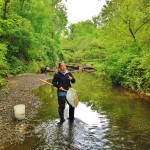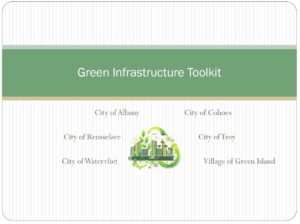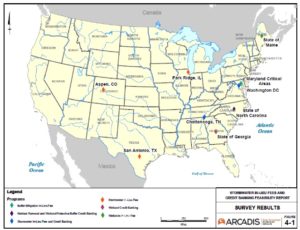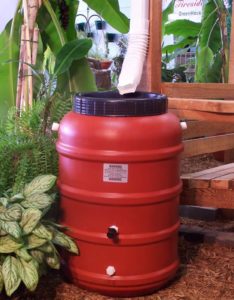604B Water Quality Program
 The federal Clean Water Act provides for funding to states for regional water quality management planning activities. The Environmental Protection Agency (EPA) awards 604(b) grants to states, which in turn make awards to regional planning and interstate organizations. Under this program CDRPC provides technical assistance to county water quality coordinating committees and MS4 communities. CDRPC, coordinates water quality outreach with the NYS DEC, and creates and participates in watershed planning activities. For the 2019-2020 year of the 604b program, CDRPC will be working with the City of Watervliet and surrounding municipalities on an effort to update the City’s Watershed Protection Study published in 2003.
The federal Clean Water Act provides for funding to states for regional water quality management planning activities. The Environmental Protection Agency (EPA) awards 604(b) grants to states, which in turn make awards to regional planning and interstate organizations. Under this program CDRPC provides technical assistance to county water quality coordinating committees and MS4 communities. CDRPC, coordinates water quality outreach with the NYS DEC, and creates and participates in watershed planning activities. For the 2019-2020 year of the 604b program, CDRPC will be working with the City of Watervliet and surrounding municipalities on an effort to update the City’s Watershed Protection Study published in 2003.
In 2020 CDRPC began working with communities to implement the The Drinking Water Source Protection Program (DWSP2), a state-run program created to assist municipalities with proactively protecting their drinking water sources. The goal is to help municipalities develop and implement their own unique drinking water source protection plan for the source(s) of their drinking water. DWSP2 is a four Agency initiative co-led by DEC and Department of Health, in collaboration with the Department of Agriculture and Markets (DAM) and Department of State. As a result of this voluntary program, participating municipalities can use their newly developed drinking water source protection plan to start implementing protection measures.
The purpose of developing a long-term protection plan for source water(s) is to protect public health and safety, and the environment. Using a drinking water source protection plan, municipalities can make informed decisions to achieve source water protection.
- Protect public health by preventing pollutants from entering a drinking water supply.
- Avoid preventable drinking water treatment costs.
- Increase community confidence in their local public drinking water.
- Create long-lasting partnerships that support implementation.
- Utilize a broad array of existing funding sources to aid with project implementation costs.
For more about the DWSP2, visit https://www.dec.ny.gov/chemical/115250.html.
CDRPC is currently working on two DWSP2 Program Watershed Protection Plan Updates
Grants and Funding for Clean Water
Aging and failing water infrastructure is increasingly putting the safety, reliability and affordability of our water at risk. Infrastructure failures such as water main breaks, sink holes, sewer collapses and pump failures are all too common a regular occurrence in many communities. Emergency repairs are expensive and disruptive. Permitted Combined sewer overlfows contribute billions of gallons of raw sewage entering our water bodies every year. Wastewater treatment plants struggle to keep up with demand, implementing the latest technologies, and reaming cost-effective. Water and sewer fee hikes, a regressive tax, are mostly felt by poor or those on a fixed income. The advocacy organization Environmental Advocates estimates that to fix our crumbling drinking water and wastewater infrastructure, it was estimated in 2008 that New York must invest close to $80 billion over the next 20 years. While the needs outpace the funding by a wide margin, thankfully there are grant and loan programs available by the Federal Government and New York that communities may tap into in effort to address the capital backlog and protect water quality. Find a comprehensive list of these program here.
Green Infrastructure Strategic Planning
Six Capital District communities (the APCs), working collectively, with support from the Albany and Rensselaer County Sewer Districts, developed a joint Long Term Control Plan (LTCP) that will, through the implementation of more than 53 projects and programs, significantly abate Combined Sewer Overflow discharges in the Hudson River and demonstrably achieve water quality. The LTCP, jointly funded and implemented by the six APCs includes several innovative Green Infrastructure (GI) strategies and reports.
What is Green Infrastructure?
Green infrastructure uses vegetation, soils, and natural processes to manage water and create healthier urban environments. At the scale of a city or county, green infrastructure refers to the patchwork of natural areas that provides habitat, flood protection, cleaner air, and cleaner water. At the scale of a neighborhood or site, green infrastructure refers to stormwater management systems that mimic nature by soaking up and storing water. More information on Green infrastructure practices can be found within the Draft NYSDEC MS4 Permit and the NYSDEC Stormwater Management Design Manual which can be found at http://www.dec.ny.gov/chemical/29072.html
Green Infrastructure Toolkit
 The Toolkit emphasizes stormwater management through retention an infiltration with a focus on urban areas and small sites – specifically focusing on volume as its main objective rather than water quality because the manual is aimed to communities with combined sewers; overflows and bacterial contamination. Check it out here.
The Toolkit emphasizes stormwater management through retention an infiltration with a focus on urban areas and small sites – specifically focusing on volume as its main objective rather than water quality because the manual is aimed to communities with combined sewers; overflows and bacterial contamination. Check it out here.
Green Infrastructure Code Audit
 The Green Infrastructure Scorecard, created by the Stormwater Coalition of Albany County and modified by CDRPC, was designed to engage communities in an in‐depth review of how local laws, ordinances, development review, design standards and natural resource protection influence stormwater management. The audit identifies barriers and gaps in the adoption of Green Infrastructure practices and low impact development. It also leads to a prescriptive set of model local laws and guidelines that can be adopted to encourage and require increased employment of GI as a stormwater management technique – thereby reducing stormwater runoff and improving water quality. Learn more and complete the Audit here. (View a recent presentation of the Audit Tool and companion GI Toolbox)
The Green Infrastructure Scorecard, created by the Stormwater Coalition of Albany County and modified by CDRPC, was designed to engage communities in an in‐depth review of how local laws, ordinances, development review, design standards and natural resource protection influence stormwater management. The audit identifies barriers and gaps in the adoption of Green Infrastructure practices and low impact development. It also leads to a prescriptive set of model local laws and guidelines that can be adopted to encourage and require increased employment of GI as a stormwater management technique – thereby reducing stormwater runoff and improving water quality. Learn more and complete the Audit here. (View a recent presentation of the Audit Tool and companion GI Toolbox)
Green Infrastructure Reference Resources
During the creation of our GI Code Audit, we encountered the need for a reference page of resources for questions that may be frequently asked, or further explanations of green infrastructure practices and ideas. Click here to view this page of helpful resources regarding green infrastructure.
Green Infrastructure In-Lieu-of-Fee and Credit & Banking Feasibility Study
 The Stormwater In-lieu Fee, Credit Banking and Trading Feasibility Report was been prepared for the APCs to assess the feasibility of establishing a Stormwater In-lieu Fee (“ILF”), Credit Banking and Trading Program for the APCs. A stormwater ILF program is an innovative alternative to traditional stormwater management funding whereby a municipality or government agency establishes a stormwater retention or detention requirement for development or redevelopment projects and allows the property owner or developer to pay a fee in lieu of meeting the stormwater runoff requirement onsite. A stormwater Credit Banking and Trading program is an innovative market-based approach to stormwater management funding whereby a municipality or government agency allows the property owner or developer to purchase stormwater credits to satisfy the retention or detention requirements or bank the credits such that they can be used by the same developer on another project. The credits are generated and provided by other property owners who have implemented stormwater runoff mitigation projects that have exceeded the requirements.
The Stormwater In-lieu Fee, Credit Banking and Trading Feasibility Report was been prepared for the APCs to assess the feasibility of establishing a Stormwater In-lieu Fee (“ILF”), Credit Banking and Trading Program for the APCs. A stormwater ILF program is an innovative alternative to traditional stormwater management funding whereby a municipality or government agency establishes a stormwater retention or detention requirement for development or redevelopment projects and allows the property owner or developer to pay a fee in lieu of meeting the stormwater runoff requirement onsite. A stormwater Credit Banking and Trading program is an innovative market-based approach to stormwater management funding whereby a municipality or government agency allows the property owner or developer to purchase stormwater credits to satisfy the retention or detention requirements or bank the credits such that they can be used by the same developer on another project. The credits are generated and provided by other property owners who have implemented stormwater runoff mitigation projects that have exceeded the requirements.
These projects were made possible by grant support from the New York State Department of State Local Government Efficiency Program, The New York State DEC Estuary Program, and the NYSDEC 604b Grant Program.
Tips and Best Practices for Homeowners and Businesses
Capital District municipalities are investing millions in infrastructure to abate CSO discharges, protect water quality, prevent localized flooding and address capital needs in their systems. Aside from supporting your local public works or water department, what can you do at your home of business to help improve water quality?
Rain Barrels
Rain barrels can provide homeowners with access to free rainwater for irrigation, gardens and washing vehicles. When installed under a downspout that would otherwise drain to an impervious surface or directly to a sewer line, the barrels can help reduce combined sewer overflows and improve water quality for receiving waters. Recognizing the benefits of rain barrels, the Albany County Soul and Water Conservation District has provided CDRPC a small batch of barrels to sell at a 50% discount. Supply is limited. Contact us to purchase one or have an in person training on use and installation. If CDRPC barrels are sold out click here for District sales.
Below, find helpful resources on the benefits, installation and maintenance of rain barrels.
- City of Albany Rain Barrel Brochure
- Rain Barrel Power Point
- How To Build A Rain Barrel
- Homeowner Rain Barrel Maintenance sheet
- Rain Barrel Set-Up and Maintenance Guidance by Albany Stormwater Coalition
- Check out this handy guide on disconnecting a downspout.
Auto Repair and Maintenance
Pollutants from automobile-related activities may include heavy metals, asbestos, oil, grease antifreeze, coolant and more. These may be essential to keeping your car in tip-top shape, but when they end up in local water bodies they can wreak havoc for aquatic life. They can also present risks to human health because of their toxicity. To prevent these pollutants from reaching stormwater, here are a few helpful tips:
- Use kitty litter to clean up spills.

Use a drip pan to collect oil and be prepared to clean up any spills - Use a commercial car wash or wash your car on a lawn or other unpaved surface.
- Never hose down repair areas to storm drains.
- Recycle fluids or ensure they are disposed of properly – NEVER anything down the storm drain.
- Recycle batteries immediately.
- Use drip pans to capture fluids.
- Eliminate the use of chlorinated solvents which are toxic and hard to dispose of. Use detergents or water based cleaners.
- Fit storage tanks with spill and overflow containment.
- Pour wash water into the sink, never into a catch basin.
- See more tips here.
Lawn Care
Everything you apply to your lawn to make it look great has the potential to end up in a creek, stream or lake where it can impact water quality or lead to the proliferation of invasive species and toxic algae blooms. Phosphorous and Nitrogen rich fertilizers may yield the biggest tomatoes on your street, but if not applied property, fertilizers containing these ingredients can end up where they never belong – in nearby water bodies – and destroy the natural balance.
- Cover and contain top soil and mulch piles when not in use.
- Compost mulch and leaves instead of sending them to the dump. Ensure lawn waste is not left in the street where it can wash into storm drains.
- Avoid using lawn chemicals and fertilizers in areas where they could wash into streams or storm drains.
- Avoid applying lawn chemicals and fertilizer in windy conditions.
- Never use pesticides or fertilizers when rain is in the immediate forecast.
- Plant gardens of native drought and pest resistant plants to collect and filter rainwater, Native plants don’t need as much fertilizer to survive.
Pools, Fountains and Hot tubs
The water used in these amenities can be hazardous to the environment. The same chlorine that helps keep your pool safe for swimming can kill essential bacteria in natural water courses.
- Never drain pools, fountains or hot tubs to a storm drain or nearby water body. If there is no suitable lawn area to discharge, call your municipality before emptying your pool into the sanitary system and drain the pool slowly using a low volume pump or siphon. Never drain in the rain!
- Never clean filters in a street or over a storm drain.
- Do not use copper-based agleasides. Control algae with substances like sodium bromide.
- Make sure water used to acid wash a pool or fountain is neutralized prior to discharge. Soda ash can be used to keep the pH between 6 and 7 before discharging.
Construction and Home Improvement
- Clean paint brushes in the sink, not outdoors.
- Contact your local municipality find out dates and places to properly dispose of excess paints through a household hazardous waste collection program.
- Sweep up construction debris to prevent it from washing into a water body to a catch basin.
- Clean up spills right away.
- Fill tanks over porous surfaces, away from sewers, storm drains or ditches.
- Have your septic system inspected one every three years.
At Your Business
- Keep dumpster and garbage can lids closed.
- Inspect dumpsters regularly to ensure there are no leaks. Repair or replace damaged dumpsters.
- Encourage employees to sweep and keep areas clear of litter to prevent it from blowing down the street.
- Install grease traps and collect bulk grease for recycling. Don’t forget to ensure spill prevention is part of the storage system. Never pour grease down the drain!
- Clean floor mats, filters, mops and garbage cans in a slop or janitorial sink. Not the parking lot, alley or the street.
- Have clean-up materials neat dumpsters, loading and delivery areas.
- See more tips here.
Pet Waste

Until Murphy learns to use the bathroom, he’s got to do his business outside. It’s a fact – no one enjoys scooping poop, but it’s your responsibility as a pet owner or caregiver to prevent pet waste from ending up in streams and lakes Pet waste is loaded with bacteria that can make people sick. When left on the ground, rainwater and melting snow can wash it into storm drains and waterways polluting streams, beaches, and drinking water.
- Pick up after your pet.
- Properly dispose of pet waste by flushing it down the toilet or placing it in a sealed bag in the trash.
- Never put waste down the storm drains, in catch basins or in bodies of water.
- On the subject of dogs and water quality – NEVER let your dog come in contact with water you believe is contaminated with an algal bloom. Many types of blooms are FATAL to dogs. Learn to recognize these toxic blooms here.
Install a Rain Garden!
Rain gardens are excellent ways to beautify your property and manage stormwater at the same time. Below, find some handy resources to learn more about the benefits, construction and maintenance of rain gardens.
- Stormwater Coalition Green Infrastructure Guidance Manual for Homeowners-Downspouts, Rain Gardens, Rain Barrels
- UCONN Rain Garden Design Guide
- University of Wisconsin Rain Garden Manual
- Vermont Rain Garden Manual
Charity Car Washes
Carwashes can be great ways to raise money for a non-profit or grass roots cause, but there are still steps that need to be taken to ensure compliance with clean water act rules and regulations and to protect the environment. Sediment in wash water can settle out in lakes, streams, or wetlands, impacting the habitat needed by fish and aquatic insects. Surfactants in soap and detergents can harm aquatic life, and create nuisance conditions (i.e., negatively affect aesthetics). Oil, grease, and hydrocarbons can harm aquatic life, and create nuisance conditions (i.e., negatively affect aesthetics).
The Michigan Department of Environmental Quality published a great primer on charity car wash best practices. The University at Albany also provides a guidance document. Access both of these resources here.
Special thanks to the Stormwater Coalition of Albany County for the development of a many of materials we reference above.
